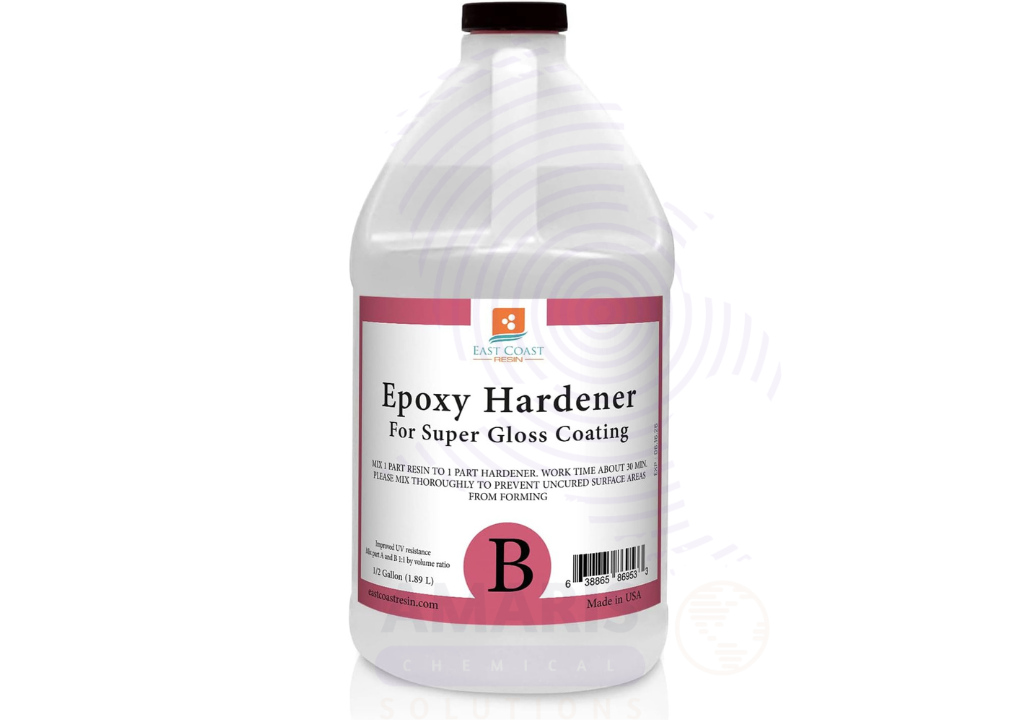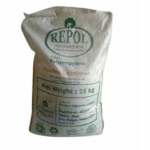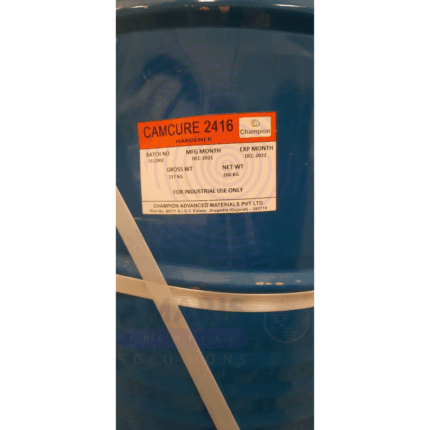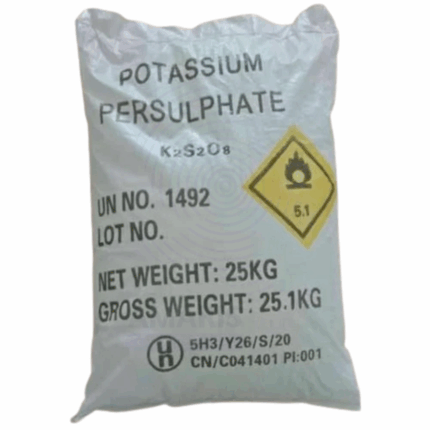Craymide Epoxy Hardener
Whatsapp Order
Craymide Epoxy Hardener is a high-performance epoxy hardener commonly used to cure epoxy resins. It is a polyamide-based curing agent that promotes excellent cross-linking with epoxy groups, resulting in coatings, adhesives, and composites with superior mechanical strength, chemical resistance, and durability. This hardener is widely used in industrial coatings, adhesives, and composite manufacturing due to its balanced curing profile and compatibility with a range of epoxy systems. Craymide 115 provides toughness and flexibility while maintaining strong adhesion to various substrates.
Description
Table of Contents
Toggle
Craymide Epoxy Hardener Uses
Primary Uses
- Industrial Coatings
- Used as a curing agent in epoxy floor coatings, primers, and protective finishes.
- Provides corrosion resistance and chemical durability in coatings for metals, concrete, and wood.
- Enhances mechanical properties such as abrasion resistance and impact toughness.
- Adhesives and Sealants
- Key component in epoxy adhesives for structural bonding in automotive, aerospace, and construction industries.
- Improves adhesive strength and heat resistance in bonding applications.
- Composite Manufacturing
- Used to cure epoxy resins in fiber-reinforced composites for marine, automotive, and sports equipment.
- Provides improved flexibility and durability in composite materials.
Secondary Uses
- Electrical and Electronics
- Employed in encapsulants and potting compounds to protect sensitive electronics from moisture and mechanical damage.
- Art and Craft
- Utilized by artisans for creating durable resin-based artworks and coatings with high gloss finish.
- Tooling and Molding
- Used in mold making and tooling applications where strong, chemically resistant epoxy parts are required.
KEY PRODUCT FEATURES
1. Basic Identification Attributes
- Chemical Name (IUPAC): Polyamide hardener (specific proprietary polyamide)
- Common/Trade Name: Craymide 115 Epoxy Hardener
- CAS Number: Not publicly specified (proprietary blend)
- HS Code: 3909.50.00
- Molecular Formula: Variable (complex polyamide mixture)
- Synonyms: Epoxy polyamide hardener
2. Physical & Chemical Properties
- Physical State: Viscous liquid or paste
- Color & Odor: Amber to brown; amine-like odor
- Melting Point: Not applicable (liquid)
- Boiling Point: Decomposes before boiling
- Density: Approx. 0.98–1.05 g/cm³ at 25°C
- Solubility: Insoluble in water; soluble in epoxy resins and some solvents
- pH: Alkaline (amine-based)
- Stability: Stable under normal storage conditions; reactive with epoxy resins
3. Safety & Hazard Attributes
- Hazard Class (GHS): Skin irritant and sensitizer (Category 2), eye irritant
- NFPA Ratings:
- Health: 2
- Flammability: 1
- Reactivity: 0
- Exposure Limits: No specific OSHA PEL; use respiratory protection if mist/vapor present
- Toxicity: Can cause skin sensitization and respiratory irritation
- Reactivity: Reacts exothermically with epoxy groups and strong acids
4. Storage & Handling Attributes
- Storage Conditions: Store in sealed containers in a cool, dry, well-ventilated area away from moisture and acids
- Container Type: Metal or HDPE drums with secure seals
- Shelf Life: Typically 6–12 months if stored properly
- Special Handling: Use PPE including gloves, goggles, and respirators when handling; avoid skin contact
5. Regulatory & Compliance Attributes
- FDA Status: Not approved for direct food contact
- REACH Status: Registered under EU regulations
- Transportation: Classified as hazardous material (flammable liquid/irritant)
- Waste Disposal: Dispose of in accordance with local hazardous waste regulations
6. Environmental & Health Impact
- Ecotoxicity: Harmful to aquatic life with long-lasting effects
- Persistence: Moderate environmental persistence
- Bioaccumulation: Not expected to bioaccumulate significantly
- Carcinogenicity/Mutagenicity: Not classified as carcinogenic
- Biodegradability: Slowly biodegradable
SAFETY HANDLING PRECAUTIONS
Safety Handling Precautions
Personal Protective Equipment (PPE):
- Chemical-resistant gloves (nitrile or neoprene)
- Protective eyewear and face shield
- Protective clothing (lab coat or coveralls)
- Respirator if ventilation is inadequate
Handling Measures:
- Avoid inhalation of vapors and contact with skin or eyes
- Use in well-ventilated areas or under fume extraction
- Wash hands thoroughly after handling
Storage Measures:
- Keep container tightly closed
- Store away from incompatible materials such as strong acids and oxidizers
Hygiene Practices:
- Do not eat, drink, or smoke while handling
- Maintain good workplace hygiene
First Aid Measures
- Inhalation: Move to fresh air immediately; seek medical attention if breathing difficulties develop
- Skin Contact: Wash affected area with soap and water; seek medical attention if rash or irritation develops
- Eye Contact: Rinse eyes thoroughly with water for at least 15 minutes; get medical help promptly
- Ingestion: Do not induce vomiting; seek immediate medical attention
Firefighting Measures
- Fire Hazards: Combustible; emits toxic fumes including nitrogen oxides and carbon oxides when burning
- Extinguishing Media: Use foam, dry chemical, or CO₂ extinguishers
- Special Precautions: Firefighters should wear full protective gear and self-contained breathing apparatus
- Decomposition Products: Toxic gases including ammonia, carbon monoxide, and nitrogen oxides
Related products
Camcure (Hardener)
Camcure is a specialized epoxy hardener designed to be used in conjunction with epoxy resins to facilitate curing, improve mechanical strength, and enhance chemical resistance. It typically appears as a clear to pale yellow liquid with low viscosity, enabling easy mixing with resin systems. This hardener is widely used in coatings, adhesives, composites, and industrial applications requiring durable, tough, and chemically resistant cured products. Camcure 9115X70 promotes rapid curing at ambient or elevated temperatures and offers excellent adhesion to a variety of substrates including metals, plastics, and concrete.
Dibutyl Phthalate
Dibutyl Phthalate (DBP) is a colorless, oily liquid with a faint aromatic odor, belonging to the phthalate ester family. It is primarily used as a plasticizer to impart flexibility, durability, and softness to rigid polymers like polyvinyl chloride (PVC). DBP is valued for its excellent compatibility with polymers, good plasticizing efficiency, low volatility, and resistance to extraction by water and oils. Besides plastics, DBP is utilized in coatings, adhesives, printing inks, cosmetics, and other industrial applications. Its moderate cost and versatile performance make it a key chemical in various manufacturing sectors.
Dicumyl Peroxide
Dicumyl Peroxide (DCP) is a widely used organic peroxide with powerful free radical initiator properties. It appears as a white crystalline solid with a characteristic odor and is primarily employed as a cross-linking agent and polymerization initiator in the plastics and rubber industries. Due to its ability to generate free radicals upon thermal decomposition, it facilitates curing and cross-linking of polymers, improving mechanical properties and heat resistance. Dicumyl Peroxide is a key component in manufacturing processes for polyethylene, polypropylene, EPDM rubber, and other elastomers.
Sodium Persulfate
Sodium Persulfate is a white crystalline powder with the chemical formula Na₂S₂O₈. It is a powerful oxidizing agent widely used in industrial and chemical applications. This 25kg packaged product is highly soluble in water and decomposes to release oxygen, making it effective for polymerization, etching, and cleaning processes. Its strong oxidation properties and stability under storage conditions make it a preferred choice for various demanding applications.


 Preservatives(food)
Preservatives(food) Flavor Enhancers
Flavor Enhancers Acidulants
Acidulants Sweeteners
Sweeteners Antioxidants
Antioxidants Colorants(food)
Colorants(food) Nutraceutical Ingredients (food)
Nutraceutical Ingredients (food) Nutrient Supplements
Nutrient Supplements Emulsifiers
Emulsifiers
 Collectors
Collectors Dust Suppressants
Dust Suppressants Explosives and Blasting Agents
Explosives and Blasting Agents Flocculants and Coagulants
Flocculants and Coagulants Frothers
Frothers Leaching Agents
Leaching Agents pH Modifiers
pH Modifiers Precious Metal Extraction Agents
Precious Metal Extraction Agents
 Antioxidants(plastic)
Antioxidants(plastic) Colorants (Pigments, Dyes)
Colorants (Pigments, Dyes) Fillers and Reinforcements
Fillers and Reinforcements Flame Retardants
Flame Retardants Monomers
Monomers Plasticizers
Plasticizers Polymerization Initiators
Polymerization Initiators Stabilizers (UV, Heat)
Stabilizers (UV, Heat)
 Antifoaming Agents
Antifoaming Agents Chelating Agents
Chelating Agents Coagulants and Flocculants
Coagulants and Flocculants Corrosion Inhibitors
Corrosion Inhibitors Disinfectants and Biocides
Disinfectants and Biocides Oxidizing Agents
Oxidizing Agents pH Adjusters
pH Adjusters Scale Inhibitors( water)
Scale Inhibitors( water)
 Antioxidants(cosmetic)
Antioxidants(cosmetic) Emollients
Emollients Fragrances and Essential Oils
Fragrances and Essential Oils Humectants
Humectants Preservatives
Preservatives Surfactants(cosmetic)
Surfactants(cosmetic) Thickeners
Thickeners UV Filters
UV Filters
 Fertilizers
Fertilizers Soil Conditioners
Soil Conditioners Plant Growth Regulators
Plant Growth Regulators Animal Feed Additives
Animal Feed Additives Biostimulants
Biostimulants Pesticides (Herbicides, Insecticides, Fungicides)
Pesticides (Herbicides, Insecticides, Fungicides)
 Active Pharmaceutical Ingredients (APIs)
Active Pharmaceutical Ingredients (APIs) Excipients
Excipients Solvents(pharmaceutical)
Solvents(pharmaceutical) Antibiotics
Antibiotics Antiseptics and Disinfectants
Antiseptics and Disinfectants Vaccine Adjuvants
Vaccine Adjuvants Nutraceutical Ingredients (pharmaceutical)
Nutraceutical Ingredients (pharmaceutical) Analgesics & Antipyretics
Analgesics & Antipyretics
 Analytical Reagents
Analytical Reagents Solvents(lab)
Solvents(lab) Chromatography Chemicals
Chromatography Chemicals Spectroscopy Reagents
Spectroscopy Reagents microbiology-and-cell-culture-reagents
microbiology-and-cell-culture-reagents Molecular Biology Reagents
Molecular Biology Reagents Biochemical Reagents
Biochemical Reagents Inorganic and Organic Standards
Inorganic and Organic Standards Laboratory Safety Chemicals
Laboratory Safety Chemicals Specialty Laboratory Chemicals(Special Laboratory Equipment)
Specialty Laboratory Chemicals(Special Laboratory Equipment)
 Demulsifiers
Demulsifiers Hydraulic Fracturing Fluids
Hydraulic Fracturing Fluids Scale Inhibitors(oil)
Scale Inhibitors(oil) Surfactants(oil)
Surfactants(oil) Drilling Fluids
Drilling Fluids
 Dyes and Pigments
Dyes and Pigments Bleaching Agents
Bleaching Agents Softening Agents
Softening Agents Finishing Agents
Finishing Agents Antistatic Agents
Antistatic Agents
 Admixtures
Admixtures Waterproofing Agents
Waterproofing Agents Sealants and Adhesives
Sealants and Adhesives Curing Compounds
Curing Compounds Concrete Repair Chemicals
Concrete Repair Chemicals Anti-Corrosion Coatings
Anti-Corrosion Coatings
 Surfactants(cleaning)
Surfactants(cleaning) Builders
Builders Enzymes
Enzymes Solvents (Cleaning)
Solvents (Cleaning) Fragrances
Fragrances
 Electronic Chemicals
Electronic Chemicals Catalysts
Catalysts Lubricants
Lubricants Photographic Chemicals
Photographic Chemicals Refrigerants
Refrigerants Automotive chemicals
Automotive chemicals Pyrotechnic Chemicals
Pyrotechnic Chemicals
 Biodegradable Surfactants
Biodegradable Surfactants Bio-based Solvents
Bio-based Solvents Renewable Polymers
Renewable Polymers Carbon Capture Chemicals
Carbon Capture Chemicals Wastewater Treatment Chemicals
Wastewater Treatment Chemicals
 Pigments
Pigments Solvents(paint)
Solvents(paint) Specialty Coatings
Specialty Coatings Binders/Resins
Binders/Resins Additives
Additives Driers
Driers Anti-Corrosion Agents
Anti-Corrosion Agents Functional Coatings
Functional Coatings Application-Specific Coatings
Application-Specific Coatings
 Fresh Herbs
Fresh Herbs Ground Spices
Ground Spices Whole Spices
Whole Spices Spice Blends
Spice Blends Dried Herbs
Dried Herbs
 Leavening Agents
Leavening Agents Dough Conditioners
Dough Conditioners Flour Treatments
Flour Treatments Fat Replacers
Fat Replacers Decoratives
Decoratives Preservatives(baking)
Preservatives(baking)
 Plasticizers & Softeners
Plasticizers & Softeners Reinforcing Agents
Reinforcing Agents Adhesion Promoters
Adhesion Promoters Vulcanizing Agents
Vulcanizing Agents Antidegradants
Antidegradants Blowing Agents
Blowing Agents Fillers & Extenders
Fillers & Extenders Accelerators & Retarders
Accelerators & Retarders























